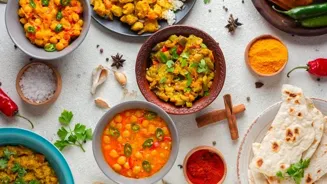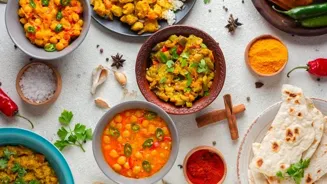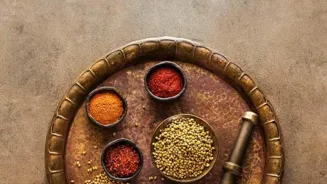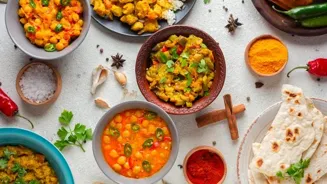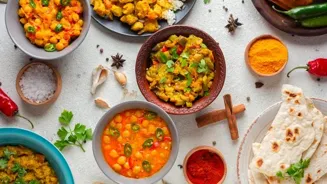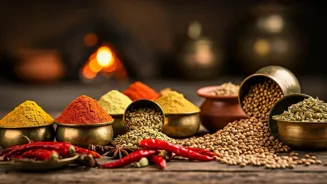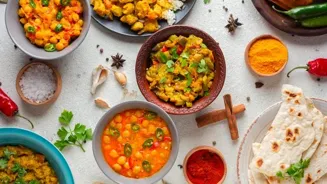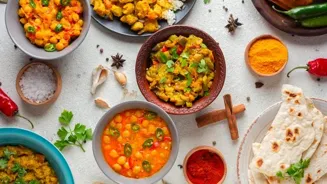Unveiling the Essence of Indian Spices: Dive into the world of flavors that define Indian cuisine. Let's discover the magic!
For any Indian household, the spice rack isn't just a kitchen accessory; it's
the very heart of cooking. It is a treasure trove of aromas and flavors, holding the secrets to creating authentic, delicious Indian dishes.
Just imagine the vibrant colors, potent smells, and the transformation that just a pinch of these spices can bring to humble ingredients.
Setting up your own spice rack can seem like a daunting task at first, but don’t worry, we'll guide you through the must-have spices to get you started on your culinary journey.
Learning about spices isn’t just about cooking; it’s about understanding a deep-rooted tradition passed down through generations. So let’s get started!
Turmeric: The Golden Spice with Health Benefits & Flavor Enhancement
First off is Turmeric (Haldi). This golden spice is definitely a must-have and is regarded as the super spice of India. It is known for its unique yellow color, a little bitter taste and its amazing health benefits.
It’s a staple in most Indian dishes, from dals and curries to vegetable preparations. It is not just about taste. It has healing properties also, which is why it has been utilized for ages in Ayurvedic medicine.
You can easily find it in powder form in most stores, however, buying turmeric roots and grinding them freshly can give a better flavor and punch. Just add a pinch of turmeric powder to warm milk with sugar before bed for a comforting and healthy drink.
A pinch of turmeric will not just bring color to your delicious recipes, it will also enhance the flavor.
Cumin (Jeera) adds flavor punch to dishes and aids digestion
Next up, we have Cumin (Jeera). These tiny, earthy seeds might look unassuming, but they pack a powerful punch of flavour. They have a warm, earthy flavor that gets even more pronounced when roasted. You can easily buy it as whole seeds or ground powder.
Cumin is usually used in tempering oils at the beginning of to help make your dish more flavorful. It is also important ingredient in many spice blends like garam masala. One easy way to use cumin is to roast the seeds, grind them lightly, and then sprinkle them over a bowl of cooling yogurt.
This gives a great refreshing snack, mostly enjoyed during summers. Cumin also has digestive properties, making it a great addition to heavy meals.
Coriander: versatile spice in Indian cuisine, seeds and powder offer distinct flavors
Coriander (Dhania) comes in both seed and powder form, each offering distinct flavors. The seeds when roasted have a citrusy and nutty flavor, while coriander powder has a milder, more rounded flavour.
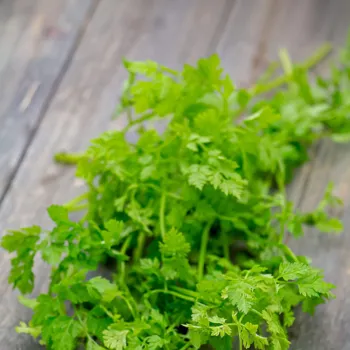
Coriander is extensively used in Indian cooking as a base spice, going well with almost any vegetable. It's an essential component of spice blends and is often sprinkled fresh as a garnish. A simple tip would be to grind coriander seeds fresh because that way you can enjoy the maximum aroma.
To use coriander effectively, try adding freshly ground coriander to your next vegetable stir-fry. It adds a layer of warmth and depth that really elevates the flavours of the dish.
Exploring the flavorful world of mustard seeds in cooking
Moving on to Mustard Seeds (Rai). These small seeds come in black and yellow varieties, each offering a unique pungent flavor. Black mustard seeds are more common in Indian cooking. When they are added to hot oil, they pop which is a signal of them releasing their flavor.
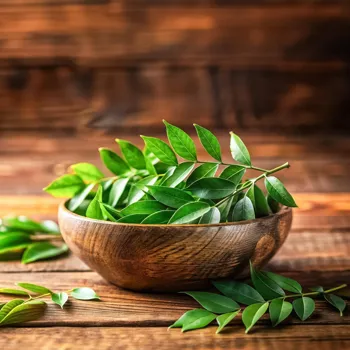
They are integral in many South Indian dishes for tempering. It can be tossed with lentils, vegetables, and even snacks. You can use a tempering of mustard seeds and curry leaves as a flavorful and aromatic addition to your dishes.
Mustard seeds are an example of how seemingly small ingredients can bring great flavor to our food. Keep them in your spice rack and explore new flavors.
Chili powder adds heat and color to dishes, choose wisely
Then add Chili Powder (Lal Mirch). This is an important ingredient for adding heat and color. There are various types available, differing widely in their spice levels. Kashmiri chili powder is known for its vibrant red color but is relatively mild, whereas others can be fiery.
Always start with a small amount and adjust according to your preference. Knowing the type of chili powder you are using helps you control the amount of heat in your dish. A dash of chili powder can make a great difference in making a vibrant flavorful and spicy dish.
It will definitely bring character to the dish.
Blend of spices for rich flavor: garam masala enhances dishes
Last but not the least, Garam Masala. This isn’t just one spice, but a blend of many spices. Garam masala usually includes cinnamon, cardamom, cloves, cumin, coriander, and black pepper. The secret to a good garam masala lies in the quality and proportion of the spices used.
Every family has their own custom version, so feel free to experiment and find your perfect blend. Garam masala is usually used at the end of the cooking process, so that the flavor and aroma is retained. Just adding a sprinkle of garam masala can instantly brighten up your dish.
It adds warmth and depth, making it unforgettable.
AI Generated Content. Glance/InMobi shall have no liability for the content
